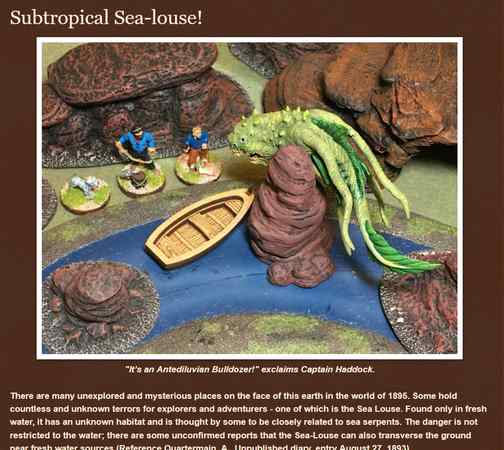I'm finally getting around to writing up further notes on making terrain tiles for use with the Four Enemies campaign system.
The campaign system is designed so that you can use one-foot-square terrain tiles to create the tabletops (though you don't have to). Now, I didn't happen to have any such tiles, so I took this as a good excuse to flex my rusty terrain skills and try some new tricks.
In this earlier article, I laid out my basic technique: a vinyl floor tile stuck down to two-inch-thick foam sheet, flocked with a product that's a combination of static grass and ground-foam flocking.
My first battle in the system, however, called for some water features. First, I needed a pond/lake tile.
I took the graphic from the campaign webpage, and came up with the profile of the pond. (Yes, I'm being a bit exacting here - you could obviously just do anything that looks like a pond!)

I then printed an enlarged copy of the outline, and used it to trace an opening on the vinyl tile.

(Unfortunately, I inexplicably stopped taking pictures at this step...)
Using a hobby knife, I cut the hole out of the vinyl tile, and glued it down to the foam. I couldn't use my hot-wire tool to scoop out the pond, as it was just a straight-line cutter. So I just hacked out the foam with an X-acto knife and my fingers - a messy and boring procedure. I wasn't sure how deep to make the pond, but ended up with a depth of almost an inch. I made sure the edges had a smooth slope, but left the pond bottom rough.
Next, I coated the pond with caulk, which covered the flaws and filled in the worst of the potholes. I then painted the pondbed a tan color. When that was dry, I coated the pondbed with white glue and sprinkled sand to provide a "beach" texture.
For the water, I decided to try something I hadn't messed with before: Realistic Water from Woodland Scenics. This is a pourable liquid which dries to create transparent "water."
The instructions were a bit sparse, but it said to put down a thin layer (about ⅛", if I recall correctly) and to let it dry for 24 hours before adding the next layer. It also said that you could add color to tint the product.
So for the first layer, I added a few drops of blue ink to give some tint to the water, and poured the first layer.
A day later, I was disappointed to see that the product had only hardened to a gelatinous consistency - I had been expecting it to completely harden. If I touched it, I left a fingerprint which would slowly fade away. Darn. I checked the bottle again, but it didn't say how hard this stuff was supposed to be. Also, the "water" wasn't completely transparent - there were milky areas.
Over the coming days, I gradually built up the pond, layer by layer. When I had it to the depth I wanted, I taped a cover over the pond, then went ahead and flocked the rest of the tile.
The tile was then set aside while I worked on other projects...
Until one day a year later, I just happened to check the tile... and surprise, the water product had hardened up!
Here's what the tile looks like today (after a few battles):

The bright lights I'm using for photography bring out the blue color. In normal "game room" lighting, the color is much darker and more subdued.
And this photo shows how I cut a sloped side into each terrain tile. This makes it easier to fit the tiles together. And I paint the sides black to make the seams between tiles less visible on the tabletop.

And here is a close-up of the pond:

I have no idea where there are whitish shadows inside the pond. (They are less evident under "normal" lighting.)
If I built this tile again using this method, I would experiment with a shallower pond. It took an entire bottle of Realistic Water to fill this pond.
However, I'm unlikely to use this product again. It didn't work well for me, and the drying time is excessive.







